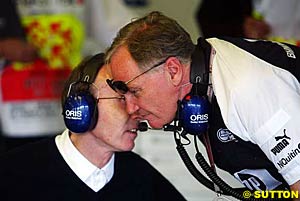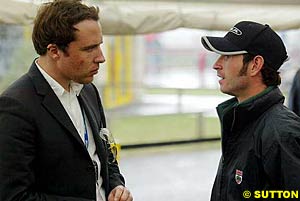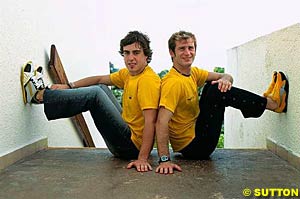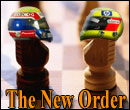
Atlas F1 Senior Writer
There is no scientifically-proven way to assess whether a driver will turn out to be the best choice or not; there are only gut feelings and calculated guesses. But there's also telemetry and plenty of data to assist the team chiefs in pursuing the black art of drivers selection - and judging on recent years, teams don't always utilise the information in the optimal way. Atlas F1's Karl Ludvigsen reflects on the selection process behind the 2005 line-up reshuffle
When I asked Frank if there were such a thing as a dead cert, he answered that "if you take away established people who came to us, people who won like Mansell, Senna and Prost, the ones that you'd want to remember of course are Button and Montoya – they're the best ones that come to mind." Patrick Head underlined this in his comment to Will Gray that "if you are looking for a driver and you want to be confident he can win races, then maybe you have got to look at drivers who have won races previously. There is nothing that beats somebody having done it before."
"What you probably want," I said to Frank Williams, "is a person who extracts the absolute ultimate from the car but preferably without going off the road." "We all dream of that, yes," Williams replied. "The drivers we've had like Nigel, like Ayrton – well I can't really quote because he was with us so little time – and Alain Prost. These are wonderful drivers who extracted almost perfection from the car."
That surely is the Holy Grail of the Formula One team chief - finding drivers who extract almost perfection from the car. "We have a philosophy at Renault," said Mike Gascoyne when he was there, "that you win races in the wind tunnel, in the design office and in the R&D labs. You can only lose them at the race track." You can only lose them, in other words, when those damned drivers get their hands on the cars!
This view had earlier been expressed by John Wyer, fabled Aston Martin team manager. "A celebrated observer of the racing scene has said that motor racing would be a splendid affair if it were not for the drivers," wrote Wyer. "I am the first to agree that there are times when it would be much simpler, but it would not then be the absorbing and fascinating study which it is." Even in the age of the computer-enhanced racing car we still need drivers, so we have to make the best of the situation.
The problem is that the drivers who can take your cars to the limit are always going to be in short supply. "There are in the world today perhaps six and certainly not more than ten drivers who might truly be described as first-class," said a renowned team manager, "and even this small number can be divided into the merely first-class and the first-class-plus. Then there are between fifteen and twenty established drivers who might reasonably be described as good second-class." This was the assessment of John Wyer fifty years ago. Things haven't changed much in the meantime.
For drivers and their managers, the methods used by the Formula One teams to assess and select drivers border on the mystical and arcane. If a racing driver didn't believe that no team in its right mind could bear to overlook him and his obvious talent, he wouldn't be ready for Formula One in any case. But drivers find it difficult to figure out just how the teams go about making their choices.
Not surprisingly, in this analytical age, some teams say that they dedicate study in depth to their driver selection. Only American baseball and cricket, I should think, match Formula One in the amount of statistical data that's available to assess a sportsman's performance. "We weighed up all the options, and went into a lot of detail, looking at lap-times in the races, in qualifying and many other factors," said Patrick Faure about Renault's jettisoning of Trulli and hiring of Fisichella. "We have evaluated a lot of different opinions within the team, and then we made our decision." The factor of the car always distorts the record, of course, but Renault-style sieving of drivers' data must help make the decision easier.
Fascinatingly, just the opposite decision was taken at Benetton-Renault for the 2002 season. Jarno Trulli was brought on board at Giancarlo Fisichella's expense. "We had to make a decision," said Mike Gascoyne. "With Jenson Button under contract we had to choose between Giancarlo and Jarno, and really in that situation there can't be a right decision, but nevertheless we had to make one; hopefully it is the right one." Much the same sentiment was expressed by Patrick Faure over his team's latest driver shift.
One reason given by Faure for Renault's decision was that "change can help a team: it will help keep us sharp and aggressive, and avoid falling into comfortable routines. The harmony between our drivers was an undoubted asset in building the team as we have done over the past three years, but when you are at the top, you need to be more aggressive, we need to see a competitive edge between our drivers. That dynamic helps drive a team forward." "Jarno and Fernando are friends," added Flavio Briatore. "We need competition within the team in order to improve the performance, in order to motivate Alonso, who at 23 is our man for the future."
Blended in these comments are two driver-selection concepts. One is that change for the sake of change can help a team. More analysis than this article can provide will be needed to assess whether this is in fact the case. I have my doubts. Continuity of a strong team seems to yield better results in the complex game of Formula One today, in which it takes time to master the team's operations, the rules, the high-tech controls and systems. Of course if you don't have a strong team and are making a change in order to build up its muscle, that's another matter.
The other concept is that internal competition between the two drivers is vital to drive a team forward. There's no doubt that this is a powerful dynamic. "It's my job to destroy my teammate," said Mark Webber. "I have to do the most I can with the car, and if I'm getting blown away by my teammate I'm doing something wrong. It's a driver's nightmare to get beaten with the same equipment." No wonder Antonio Pizzonia thought it necessary to rubbish the equipment that Jaguar gave him, as a psyche-saving boost to his self-esteem after being waxed by Webber last year.
The last aspect of driver selection we can look at here is the test-driver syndrome. Some test drivers, such as Nigel Mansell, David Coulthard, Mika Hakkinen and Damon Hill, have successfully graduated to race drivers and, in three of those four cases, World Champions. Mika Salo elected to test for Toyota before getting a race assignment, only to lose it. Olivier Panis is the poster boy for testers, having stepped back to that role for McLaren and then returned to front-line service with BAR and Toyota. Other test drivers reckon they should have a chance to do the same.
At Ferrari we have Luca Badoer, a veteran of 50 Grands Prix for Lola, Minardi and Forti, as a tester with Luciano Burti, who moved up from tester to racer for Jaguar. Former Benetton man Alex Wurz tests for McLaren, while Marc Gene and Antonio Pizzonia test for BMW Williams. Theirs is the most interesting case, for they're being given opportunities to race this year with Ralf among the wounded.
What are their chances of bagging a full-time drive for Williams? Slim to none, if we credit Patrick Head's view that "if you have the same test drivers you will generally maintain continuity and car development. The drivers that you have are experienced and you can put some weight on their opinions. If you have new drivers, you have got to learn again." In other words, at a time when BMW Williams is changing both its racing drivers, needlessly roiling its test-driver ranks at the same time would be asking for even more trouble.
At the beginning of 2001 Niki Lauda was asked whether his countryman Alex Wurz would ever regain a racing ride after his decision to test for McLaren-Mercedes. "I don't think so," said Lauda. "If you are a test driver, you are a test driver. Let's wait and see, but it is difficult." Patrick Head used almost the same words, saying, "The transition from testing to racing is quite difficult." So far, Lauda's forecast has been a good one. Will Gene or Pizzonia prove him and Head wrong? It seems unlikely.
How quickly things can change on the driver front! When I interviewed Frank Williams in 2002, I complimented him and his business partner Patrick Head on the length and depth of their driver strategy. "It seems to me that you - and I have to give some credit to McLaren - are the farthest-thinking team in terms of drivers," I suggested. "You seem to have the longest-range strategy in terms of drivers." And here we are only two years later with the BMW Williams driver cadre in a state of total meltdown.
 To his credit, Frank didn't claim that he had a firm handle on his drivers for the future. "I think for us more than most other teams it's to try and get a driver's prospects well arranged for several years, a number of years," he said. "It doesn't always work, mind you! I must say also that we're reluctant to look too far down the road because you can make investments that just never work out, and we're not in that business. We try and go for a dead cert against the odds of failure."
To his credit, Frank didn't claim that he had a firm handle on his drivers for the future. "I think for us more than most other teams it's to try and get a driver's prospects well arranged for several years, a number of years," he said. "It doesn't always work, mind you! I must say also that we're reluctant to look too far down the road because you can make investments that just never work out, and we're not in that business. We try and go for a dead cert against the odds of failure."
 "My partner Patrick and I spend a lot of time thinking and talking and exchanging ideas about drivers," Frank Williams told me, "and we have some good people - including my son and one or two journalists whom I respect very much - who are always out looking. I don't think they're genuine talent scouts; they've just got lots of time. They adore looking around and they're out there looking at the Formula 3 cars and the go-karts. They do a lot of homework." John Wyer did the same thing, attending club races in Britain, which he saw as the "nursery slopes" for coming racers. "In these days of driver famine," he said, "one driver of real promise discovered in a year is an adequate reward."
"My partner Patrick and I spend a lot of time thinking and talking and exchanging ideas about drivers," Frank Williams told me, "and we have some good people - including my son and one or two journalists whom I respect very much - who are always out looking. I don't think they're genuine talent scouts; they've just got lots of time. They adore looking around and they're out there looking at the Formula 3 cars and the go-karts. They do a lot of homework." John Wyer did the same thing, attending club races in Britain, which he saw as the "nursery slopes" for coming racers. "In these days of driver famine," he said, "one driver of real promise discovered in a year is an adequate reward."
 I find it hard to imagine that Trulli and Alonso are playing patty-cake on the track because they are buddies. The natural competition between teammates is so strong that it must surely prevail over personal ties, if these guys are racers at all. Yet if Flavio, famed for his driver management, holds this view, there must be something in it. Taken to an extreme, as with Ralf Schumacher and Juan Pablo Montoya, mutual dislike doesn't seem to be helping. Broadly, we have to accept that what the top teams are looking for are drivers who will work with their own car and engineers to blow off everyone else, including their teammate.
I find it hard to imagine that Trulli and Alonso are playing patty-cake on the track because they are buddies. The natural competition between teammates is so strong that it must surely prevail over personal ties, if these guys are racers at all. Yet if Flavio, famed for his driver management, holds this view, there must be something in it. Taken to an extreme, as with Ralf Schumacher and Juan Pablo Montoya, mutual dislike doesn't seem to be helping. Broadly, we have to accept that what the top teams are looking for are drivers who will work with their own car and engineers to blow off everyone else, including their teammate.
About the author:
Long time columnist at Atlas F1, Karl Ludvigsen is an award-winning author and historian who managed racing programs for Fiat in America in the late 1970s and Ford of Europe in the early 1980s. He is the author of seven books about racing drivers and numerous books about classic racing cars and engines, all of which draw extensively on the many images in his Ludvigsen Library in Suffolk, England.
![]()
Contact the Author
Contact the Editor
Please Contact Us for permission to republish this or any other material from Atlas F1.
|
Volume 10, Issue 31
Atlas F1 Special
The Stars Align
Boy Wonder
In Search of the Holy Grail
Chemistry Cocktail
The Conservative Party
The Reshuffle: Facts & Stats
The Reshuffle Trivia Quiz
Columns
On The Road
Elsewhere in Racing
The Weekly Grapevine
> Homepage |
